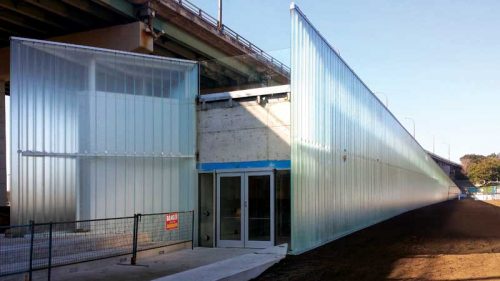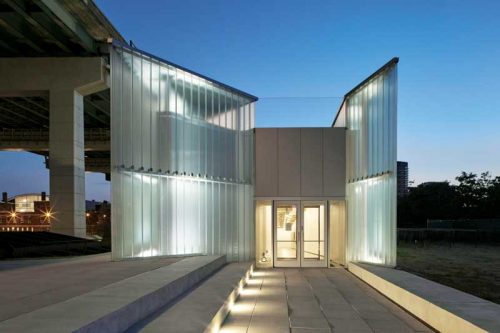Building for the future on a national historic site

Photo © Fred Fulton. Photo courtesy Bendheim Wall Systems
On the firm’s website, Patkau Architects describe this part of the visitor experience as:
A multi-media immersive ‘time-tunnel’ portraying the dramatic events of the War of 1812/14 rises from the entrance level to emerge on the Commons, connecting the modern city below to the Fort above. The time tunnel is a threshold, a passage in time from present day to the founding of the city. Walking up the gentle switchback slope, visitors are invited to undertake a pilgrimage through the site’s history, arriving at a site virtually unchanged in two centuries. Behind, the building emerges from the ground at the level of Garrison Common as an illuminated wedge, clad in backlit cast glass channels. The roof of this wedge is paved, offering elevated views of the entire Fort and the Toronto skyline beyond.
Once through the ‘time tunnel’ and inside the fort proper, the visitor centre appears completely transformed. Gone are the heavy, weathering escarpments and steep walls of ochre steel. Instead, guests exit the visitor centre through two expansive translucent walls made entirely of channel glass. Illuminating the fort’s history, the graceful glass walls become part of the guest experience, as visitors step onto the fort grounds, while the linearity of the channel glass echoes the centre’s ‘timeline’ theme.
Defining the upper levels and running the entire length of the centre, the channel glass façade rises from the landscape. The cladding was originally imagined as a stainless steel screen wall—a surface to be used for projecting images of battlefield scenes from the fort’s lifetime. The projectable screen idea was not financially feasible, and a new solution was needed to create the desired dynamic, captivating experience for visitors.
To create the cladding for the two upper exterior walls of the centre, the architects selected a channel glass rainscreen configured as a dual-function architectural element—visually highlighting the new structure while addressing more than 90 per cent of the imposed forces of nature.

Photo © Riley Snelling. Photo courtesy Bendheim Wall Systems
Channel glass is translucent, U-shaped, machine-rolled (i.e. ‘cast’) glass, available in face widths ranging from 230 to 480 mm (9 to 19 in.). Its unique geometry allows it to withstand imposed forces in ways conventional flat glass cannot, creating virtually seamless glass walls uninterrupted by metal frames. Installed vertically, the glass can span heights up to 7 m (23 ft) and virtually limitless lengths—hundreds of metres or more—a distinct advantage over traditional flat glass. At 7 mm (0.28 in.) thick, individual glass channels are lightweight, facilitating handling and installation. They can be installed by as few as two people, without the need for cranes or other heavy-lifting equipment.
Understanding channel glass
Channel glass rainscreen systems, such as the one cladding the new Fort York Visitor Centre, offer a robust layer of protection to new buildings’ structural walls, preserving structures from the elements and ensuring their longevity. They feature a streamlined linear esthetic, signature to this unique glass type.
A non-porous, non-combustible building material, channel glass can withstand the punishing forces of water, wind, and time. It offers ease of maintenance, durability, and an upscale esthetic. Unlike other rainscreen cladding materials, channel glass can also allow more than 85 per cent of visible light through, maintaining daylight advantages in applications featuring windowed structural walls behind the rainscreen.
At the new Fort York Visitor Centre, about 1000 m2 (11,200 sf) of tempered safety channel glass create a back-lit rainscreen façade, set roughly 0.7 m (2.25 ft) from the building’s exterior walls. The single-glazed, closed-joint, open-wept cladding system (i.e. bottom frame has deep holes to control drainage) provides protection from the elements—wind, rain, snow, and ice—and effectively controls water drainage. The extrusions are aluminum alloy 6063-T5 in standard Class 1 Clear Anodized finish.
The tempered, Safety Glazing Certification Council (SGCC)-certified glass channels are pocket-set into the frame system and captured at the head and sill only, creating a virtually seamless glass façade along the entire length of the building. The light-diffusing ‘orange peel’ channel glass surface texture effectively combines the esthetic benefits of translucency and back-lighting ability. Rigid insulation covers the structural walls behind the glass, providing enhanced thermal performance and forming a uniform, light-washed backdrop for the glass. Lighting fixtures attached to the back of the channel glass systems’ head and sill steel supports illuminate the centre at night, producing an ethereal glow.
The frame system design, eliminating the need for vertical metal supports, allows walls of uninterrupted channel glass, including glass-to-glass corners in a variety of angles, from 20 to 160 degrees. Unique to this proprietary system, visually identical head and sill frame components contribute to the consistent, clean look of the glass façade.





